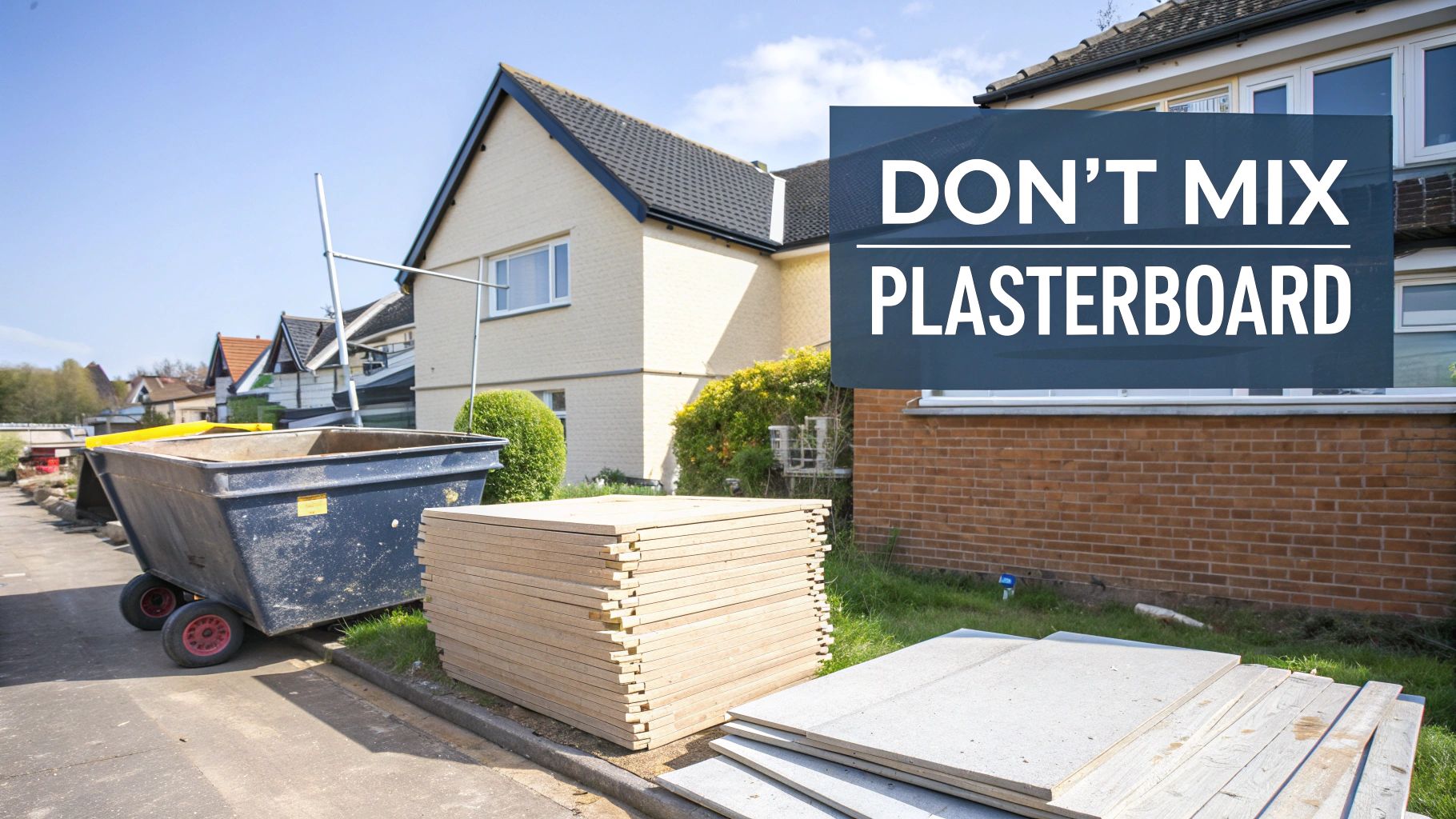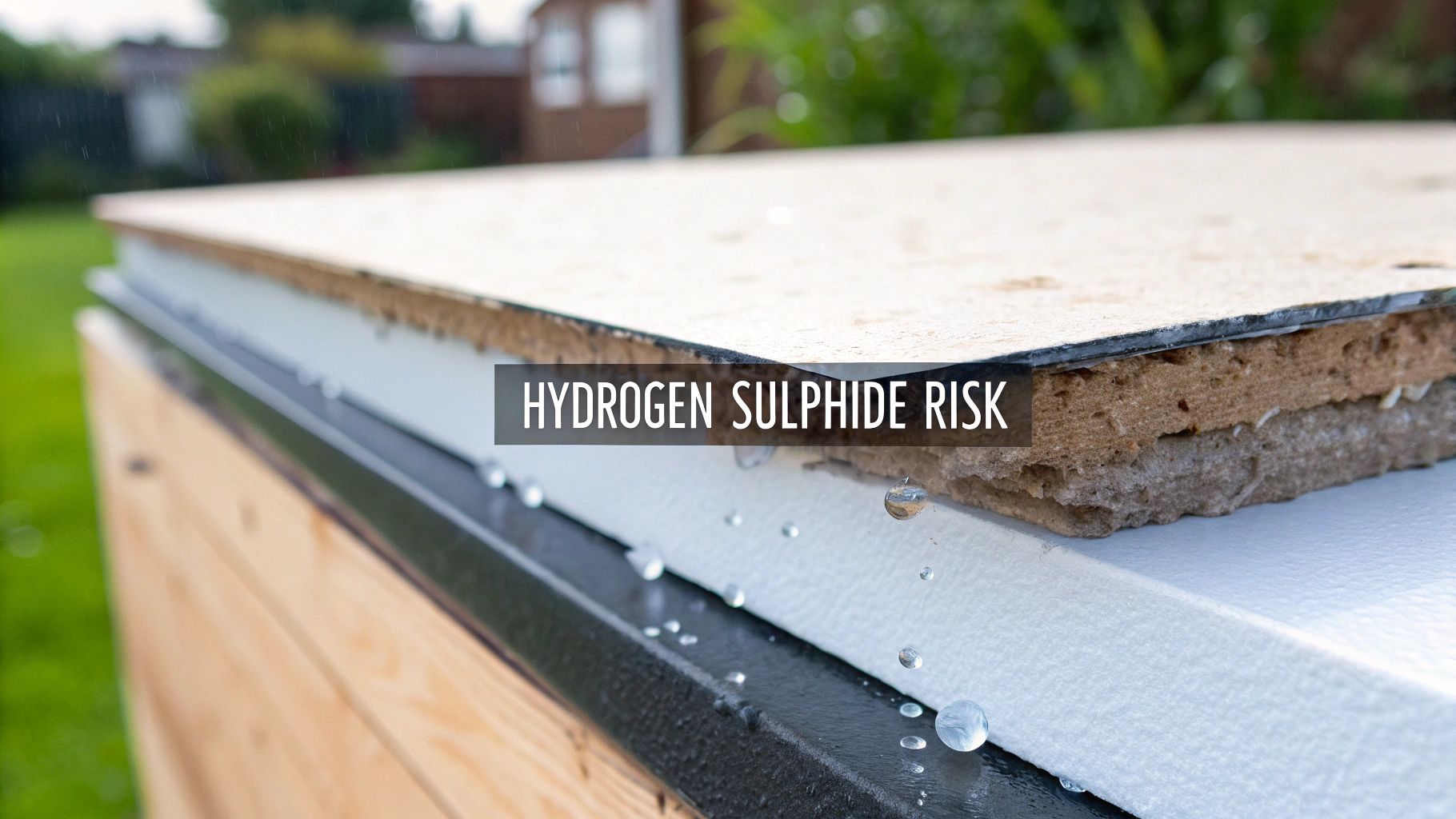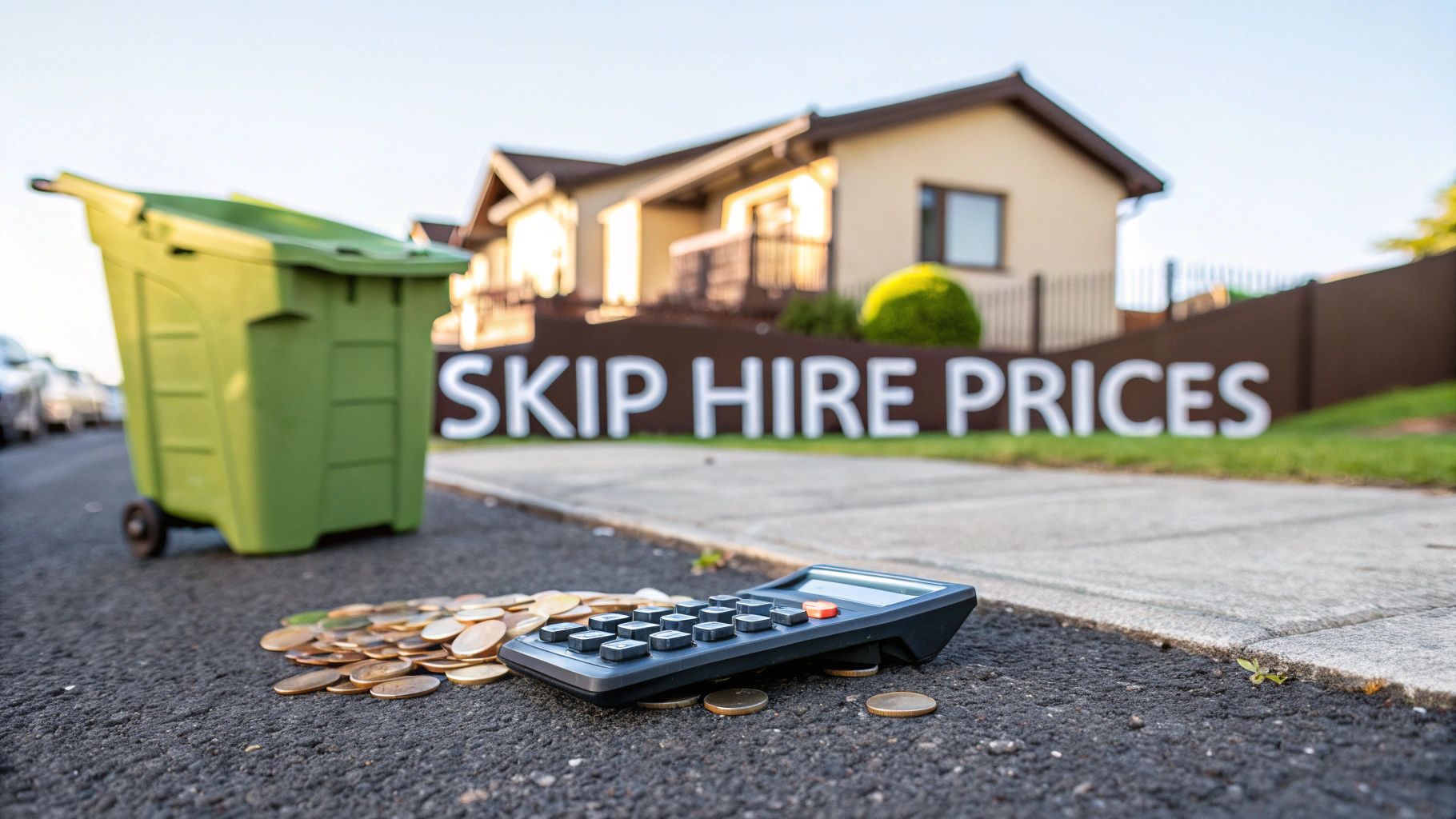Putting Plasterboard in Skips Your Essential UK Guide
Putting Plasterboard in Skips Your Essential UK Guide
The short answer? No, you can't legally mix plasterboard in a skip with your general rubbish. UK environmental rules are really strict about this, and for a very good reason. When its main ingredient, gypsum, gets wet and breaks down with other waste, it can release a pretty nasty toxic gas.
Understanding the Rules for Plasterboard in Skips

Before you even think about starting that demolition or renovation project, getting your head around the rules for plasterboard disposal is an absolute must. Ignoring them isn't just a minor slip-up; it can land you with fines, a rejected skip collection, and bring your project to a grinding halt.
The golden rule is segregation. You have to keep plasterboard completely separate from everything else.
This isn't just pointless red tape. It's a critical safety measure. Think about it: the UK uses around 270 million square metres of plasterboard every single year, so the potential for it to be disposed of incorrectly is massive. When the gypsum in plasterboard gets damp and mixes with biodegradable waste (like in a mixed skip or landfill), it can produce hydrogen sulphide gas. It's foul-smelling and harmful. You can get more insights into plasterboard's environmental impact over on this helpful article from tj-waste.co.uk.
To make things crystal clear, we've put together a quick guide on what you need to do—and what you definitely need to avoid.
Quick Guide to Plasterboard Disposal
This table breaks down the essentials for handling plasterboard waste correctly. Sticking to these guidelines will keep you on the right side of the law and ensure everyone stays safe.
| Action | Do | Don't |
|---|---|---|
| Segregation | Always keep plasterboard separate from all other waste. No exceptions! | Mix plasterboard with general rubbish, soil, or garden waste. |
| Containers | Use a dedicated plasterboard-only skip or specialist waste bags. | Try to hide plasterboard at the bottom of a mixed-waste skip. |
| Weather | Keep your plasterboard waste dry and covered to stop it from getting wet. | Leave plasterboard exposed to the rain or any damp conditions. |
Following these simple steps ensures that the plasterboard can be recycled properly and prevents any hazardous situations from developing at the waste facility. It’s a small effort that makes a big difference.
Why Plasterboard Needs Separate Disposal

To really get why you can't just chuck plasterboard into a mixed skip, we need to look at what it’s actually made of. These rules aren't just red tape; they’re in place to stop a simple but pretty nasty chemical reaction.
The core of plasterboard, or drywall as it's often called, is made from a mineral called gypsum. While it's perfectly safe and stable holding up the walls in your house, things change when it gets damp and buried amongst general waste in a landfill.
Think of it like accidentally mixing the wrong cleaning products under the sink. When gypsum gets wet and is starved of oxygen (a perfect storm in a landfill), certain bacteria get to work breaking it down. This process releases a foul-smelling and dangerous gas: hydrogen sulphide (H₂S).
And this isn't a small problem. Hydrogen sulphide is toxic, flammable, and poses a real risk to people and the planet. Suddenly, that rule about keeping plasterboard separate goes from being an annoying inconvenience to a vital safety measure.
The Dangers of Hydrogen Sulphide Gas
The release of H₂S is the number one reason behind the strict rules for plasterboard disposal. It creates several serious issues:
- A Pungent Odour: The gas has a powerful and unmistakable "rotten egg" smell that can become a real nuisance for communities living near landfill sites.
- Health Risks: Breathing in even low concentrations can cause headaches, nausea, and irritate your lungs. At higher levels, it's extremely dangerous.
- Environmental Damage: H₂S pollutes the air and can cause harm to local ecosystems.
By keeping plasterboard waste separate, you are directly preventing this hazardous chemical reaction. This simple act of segregation protects waste management workers, the public, and the environment from the effects of toxic gas exposure.
Properly separating your plasterboard isn't just about ticking a box and following the rules—it's about being responsible. For more information on dealing with different building materials, our guide on the disposal of plaster offers some extra handy insights.
Getting to Grips with UK Plasterboard Waste Rules
Knowing the science behind why plasterboard needs special handling is one thing, but knowing the actual rules is another beast entirely. The UK Environment Agency has laid out some very clear regulations for this stuff, and they don't just apply to massive construction firms – they’re for everyone, from homeowners doing a bit of DIY to seasoned tradespeople.
The golden rule is segregation.
Put simply, this means you absolutely must keep plasterboard and anything gypsum-based completely separate from all your other rubbish. This isn't just a friendly suggestion; it's the law. Think of it exactly like your household recycling – you wouldn't chuck glass bottles in with your paper waste. Plasterboard demands that same level of care right from the moment it’s pulled off the wall.
This rule didn't just appear out of nowhere. It's the result of years of recognising just how big a problem construction waste is. To give you some perspective, way back in 2014, the UK generated a staggering 202.8 million tonnes of total waste. Over 58.9% of that came from construction and demolition. The push for smarter waste management has been on for a long time, and these regulations are a direct result. You can find more detail on the UK's efforts to reduce construction waste on assignmentworkhelp.com.
Who Do These Rules Actually Affect?
There’s a common myth that these strict rules are only for big commercial jobs. The reality is that the legal "duty of care" for waste applies to absolutely everyone.
- Homeowners: If you're doing up a room and hire a skip, you're the one responsible for making sure plasterboard doesn't get mixed in with everything else.
- Tradespeople: Builders, plasterers, and other pros have to have a system in place to keep plasterboard separate while on site.
- Skip Hire Companies: We are legally not allowed to collect skips that have plasterboard mixed in with other waste. If we do, we have to pass on some hefty contamination charges.
Don't underestimate the consequences of getting this wrong. You could be looking at serious fines from your local council or the Environment Agency. On top of that, your skip provider will almost certainly refuse to collect the contaminated skip, leaving you with a massive headache, project delays, and extra costs.
The message is crystal clear: segregating plasterboard isn't optional. The only way to keep your project running smoothly and legally is to plan for separate plasterboard disposal from the very beginning.
Your Practical Options for Disposing of Plasterboard
Alright, so you know the rules. But what does that mean in the real world when you've got a pile of old plasterboard to get rid of? Thankfully, dealing with plasterboard waste doesn't have to be a headache. The best route for you really just boils down to the size of your project.
Finding the Right Disposal Method
For those smaller DIY jobs – maybe you've patched a hole or taken down a single stud wall – plasterboard waste bags are usually your best bet. They're tough, purpose-built bags designed specifically for gypsum waste, making it dead simple to keep things separate and manage the load.
On the other hand, if you're tackling a full-on room renovation or a bigger construction job, hiring a dedicated plasterboard-only skip is the most straightforward way to go. It gives you plenty of space and makes segregation on-site a no-brainer, stopping any accidental mixing with your other rubbish.
It's all about striking a balance between cost, convenience, and how much waste you're actually producing. A dedicated skip makes life easy for a big job, while bags save you from shelling out for a massive container you just don't need for a small task.
Another solid option, especially for tiny amounts, is to take it down to your local Household Waste Recycling Centre (HWRC). Just be sure to check their policy online first. Many councils will take it, but they often have strict rules on quantity and might need you to book a slot in advance.
Think of it like this – a simple decision tree can guide you to the right choice for keeping your plasterboard waste safely segregated.

The one thing to remember? Mixing plasterboard with your general waste is completely off the table. It can lead to fines or your skip company refusing to collect it.
Choosing Your Plasterboard Disposal Method
To help you make the right call, we've put together this quick comparison table. It lays out the most suitable and cost-effective disposal options to help you choose what's best for your project.
| Disposal Method | Best For | Typical Cost | Key Advantage |
|---|---|---|---|
| Plasterboard Bags | Small DIY tasks, repairs, and minor renovations | Lower initial cost per bag | Cost-effective for low volumes |
| Dedicated Skip | Large renovations, construction sites, and extensions | Higher cost, varies by skip size | Handles large quantities efficiently |
| Council HWRC | Very small amounts from domestic projects only | Often free, but check local council rules | No cost for homeowners with minimal waste |
No matter which path you take, keeping that plasterboard separate and dry is the golden rule. It’s absolutely essential for staying compliant and making sure the material can be properly recycled.
Of course, once the old stuff is out, you might be thinking about the new. If your project involves putting up fresh walls, you might want to get a quote for professional plastering services to get that perfect finish.
And if you want to dive deeper into the green side of things, check out our guide on how to recycle plasterboard and play your part in a more sustainable construction cycle. Choosing the right disposal method means your project stays on track and, crucially, on the right side of the law.
The Real Cost of Handling Plasterboard Waste

It can be tempting to sneak a bit of plasterboard into a general skip to save a few quid. We get it. But this approach almost always backfires, ending up costing you a lot more than you bargained for. Doing things by the book isn't just about ticking boxes for the Environment Agency; it's genuinely the smartest move for your wallet.
When you hire a dedicated plasterboard skip or use the proper waste bags, you get a clear, upfront cost. Yes, it might be a little different from a standard mixed-waste skip, but that small difference buys you complete peace of mind. The real financial headache comes from the hidden costs of getting it wrong.
If plasterboard ends up in your mixed-waste skip, you're opening yourself up to some pretty hefty financial penalties. Your skip hire company will likely either refuse to collect it until you've sorted it out or slap you with a significant contamination charge to cover their costs for manually separating everything.
The Hidden Financial Penalties
That tiny saving you thought you made by not getting a separate bag or skip? It vanishes in a flash when the consequences hit.
- Contamination Surcharges: Skip companies are legally required to dispose of plasterboard correctly. They won't absorb the cost of your mistake; they'll pass the bill for sorting and separate disposal straight on to you, and it can be substantial.
- Wasted Time and Labour: If your skip collection is refused, the project grinds to a halt. You'll be the one fishing out plasterboard by hand, wasting valuable time and effort that could have been spent on the actual job.
- Official Fines: The Environment Agency doesn't mess about with illegal waste disposal. Their fines are designed to be a serious deterrent and can easily spiral into thousands of pounds for non-compliance.
Trying to hide plasterboard in a mixed skip is a false economy. The potential fines and extra charges almost always exceed the cost of hiring a separate, dedicated plasterboard skip or using the correct waste bags from the start.
Ultimately, once you understand the risks, the choice becomes simple. By planning ahead for your plasterboard disposal, you shield your budget from nasty surprises and keep your project running smoothly without any costly delays. You can learn more about how different factors influence the cost of skip hire near me in our detailed guide.
Common Questions About Plasterboard in Skips
Even when you know the rules, real-world situations can leave you scratching your head. Let's run through some of the most common questions we get about handling plasterboard in skips. This should give you the confidence to get it right every time.
One of the first things people ask is how much plasterboard they can actually get into a dedicated skip. It’s not just about volume; the real limit is weight. Plasterboard is surprisingly heavy, and that weight adds up fast when you stack it. Overload a skip by weight, even if it looks like there's room to spare, and you risk the collection crew refusing to take it.
This focus on careful management has been a long time coming. The industry started to get serious about this back in 2002 with early take-back schemes for recycling plasterboard from new builds. By 2004, one major contractor was already segregating 72% of its plasterboard waste — a whopping 4,831 tonnes that were kept out of landfill. It was a massive step in the right direction. You can find more on the history of plasterboard recycling in this Eurogypsum report.
What About Contaminated Boards and Small Jobs?
Another frequent question is about plasterboard that still has tiles, wallpaper, or a lick of paint on it. Can that still go in a plasterboard-only skip?
It’s a tricky one. Any contamination makes the recycling process much harder. While a tiny bit might get a pass, your best bet is to strip off as much of the other stuff as you can. It's always worth a quick call to your skip provider to double-check their rules on contaminated plasterboard before you start loading.
But what if you only have a couple of sheets left over from a small repair? Hiring a whole skip for that feels like overkill. Luckily, you’ve got better options:
- Plasterboard Waste Bags: These are brilliant for small amounts. They offer a cheap and easy way to keep your plasterboard separate without the cost of a full skip.
- Your Local Tip: Most Household Waste Recycling Centres (HWRCs) will take small quantities from home DIY projects. Just check their website first, as some have restrictions or require you to book a slot.
For those minor jobs, these smaller-scale solutions are almost always the smartest and most budget-friendly way to stay compliant.
Whether your project is big or small, getting the waste management right is crucial. At The Waste Group, we offer a full range of compliant solutions, including dedicated skips for plasterboard, to keep your job running smoothly. Plan your disposal with confidence by visiting us at https://www.thewastegroup.co.uk.


